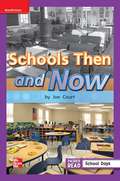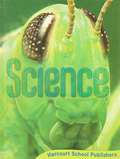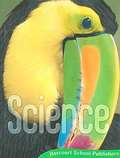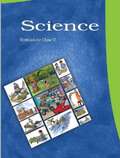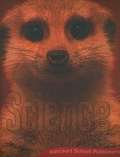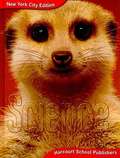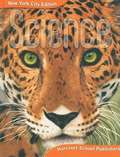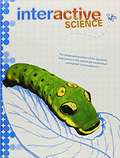- Table View
- List View
Science
by McGraw-HillScience textbook. As you read, you'll learn about the Methods of Science, the steps scientists follow to solve problems.
Science & Life Issues: Our Genes, Our Selves
by University of California at Berkeley Lawrence Hall of ScienceScience and Life Issues, or SALI, uses several kinds of activities to teach science. For example, you will design and conduct an experiment to investigate human responses. You will explore a model of how species compete for food. And you will play the roles of scientists learning about the causes of infectious disease. A combination of experiments, readings, models, debates, role plays, and projects will help you uncover the nature of science and the relevance of science to your interests.
Science (California Edition)
by Lucy Daniel Joanne Vasquez Jay Hackett Richard Moyer Pamela Stryker Prentice BaptisteBegin each topic with an Explore question. Then try an Explore Activity Read the Science Magazines. National Geographic World of Science is the first magazine in each unit. Answer fun questions about real-world facts Have fun solving Problems and Puzzles. Write in the Science Journal about what you learn Build your skills with Skill Builders. Use the Handbook for help.
Science (English Medium) class 6 - Karnataka Board
by National Council of Educational Research and TrainingThe Science - Sixth Standard textbook by the Karnataka Textbook Society, developed under NCERT guidelines, is designed to connect classroom learning with students’ everyday experiences. Emphasizing inquiry-based and activity-driven education, the book encourages children to observe, question, experiment, and reflect on the natural world. The curriculum covers a wide range of topics from food sources and components, plant and animal life, materials and their properties, to physical phenomena like light, motion, electricity, and magnets. Chapters are structured to include hands-on activities, relatable examples, and reflective questions, fostering both conceptual understanding and curiosity. The textbook also integrates essential values such as environmental awareness, scientific temper, and social responsibility. It features child-friendly characters like Paheli and Boojho to engage learners in a conversational tone throughout. Developed collaboratively by experts and educators, the book aims to support holistic development and lay a strong foundation in science for young learners, aligning with the vision of the National Curriculum Framework (2005) to create a joyful and meaningful learning environment.
Science (Grade #2)
by HarcourtHarcourt science covers science broadly in 3 topics namely life, earth and physical.
Science (Grade #5)
by Scott ForesmanInteractive Science is a next generation K-8 science program featuring an innovative write-in student edition (grades 1-8) that makes learning personal, relevant, and engaging.
Science (Grade 5, 3rd Edition)
by Peggy S. Alier Janet E. SnowYou have a textbook that is the culmination of decades of research, experience, prayer, and creative energy.
Science (Grade 8, South Carolina Edition)
by Mcdougal LittellMcDougal Littell Science pulls together units from the different categories of science to give you a broad picture of how scientists study nature. For example, physical scientists, earth scientists, and biologists might all study forces and their effects from different points of view.
Science (New York City Edition)
by Marjorie Frank Barbara Ten Brink Michael J. Bell Gerald H. Krockover Joyce C. Mcleod Carol J. Valenta Barry A. Van Deman Michael A. DispezioThis science textbook has been specially created for students in New York City. Inside there are Science Investigations, special features like Science Spin from Weekly Reader and lots of links for online exploration.
Science (Ohio Edition )
by HarcourtThis Science, Ohio Edition contains Earth and Space Sciences, Life Sciences, Physical Sciences, Ohio Expeditions, etc.
Science (Scott Foresman Science, 2003)
by Jim Cummins Timothy Cooney James Flood Barbara Kay Foots M. Jenice Goldston Shirley Gholston Key Diane Lapp Sheryl A. Mercier Karen L. Ostlund Nancy Romance William Tate Kathryn C. Thornton Leon Ukens Steve WeinbergNIMAC-sourced textbook
Science 10th Standard - Tamilnadu Board
by Training State Council of Educational ResearchScience Textbook for the 10th Standard Students preparing for Tamil Nadu State Board Exam.
Science 1: Student Guide, Part 1
by K12Hands-on exercises and reflections on topics such as: Acting Like a Scientist Matterland Everyday Weather Animal Classification Adaptations
Science 1: Student Guide, Part 2
by K12Hands-on science exercises and reflections, including: Light Up Your Life Our Green World Habitats Oceans and Undersea Life The Human Body
Science 2008: Interactive Study Guide (Grade #5)
by Timothy CooneyThe Interactive Study Guide can be used along with your textbook to help you master science concepts. For every lesson there is a Lesson Summary. You can review the vocabulary by reading the definitions and then seeing how they are used in context. After reading the Lesson Summary, answer the Lesson Questions. Sometimes you will be directed to find answers in the Lesson Summary by circling or underlining key words or concepts.
Science 2016 Student Edition Grade 3
by Scott Foresman"Pearson's K-8 Interactive Science program features 3 pathways to match the way your students learn and the way you like to teach! With Interactive Science, students can write in their books giving them a true sense of ownership. Students get all of the content, interactivity, and practice they need between the covers of a single book. Interactive Science features multiple levels of inquiry scaffolded to provide access for all learners"--provided by publisher.
Science 3
by Bju Press StaffThe Science 3 Student Text provides age-appropriate scientific information through text, diagrams, and charts, as well as annotated photographs and illustrations. Special interest boxes occur throughout the book and Quick Check sections are included in all text lessons. The Student Text also contains instructions for experiments, activities, and projects. The last page of each chapter provides key terms and concepts as well a brief writing exercise that applies higher-level thinking skills.
Science 3 Student Guide Part 2
by The Editors at the K12Table of Contents: Unit 6: Physical and Chemical Changes of Matter Unit 7: Human Body Unit 8: Energy Unit 9: Light Unit 10: Sun, Earth, and Moon Unit 11: The Solar System and Beyond
Science 4 2nd Edition
by Peggy S. Alier Janet E. Snow Joyce GarlandScience 4 Student textbook for 4th grade.
